Is it Okay to Fertilise Your Lawn After Mowing?
A beautiful, lush lawn is a source of pride for many homeowners. It not only adds to the aesthetics of your property, but also provides a functional space for outdoor ...

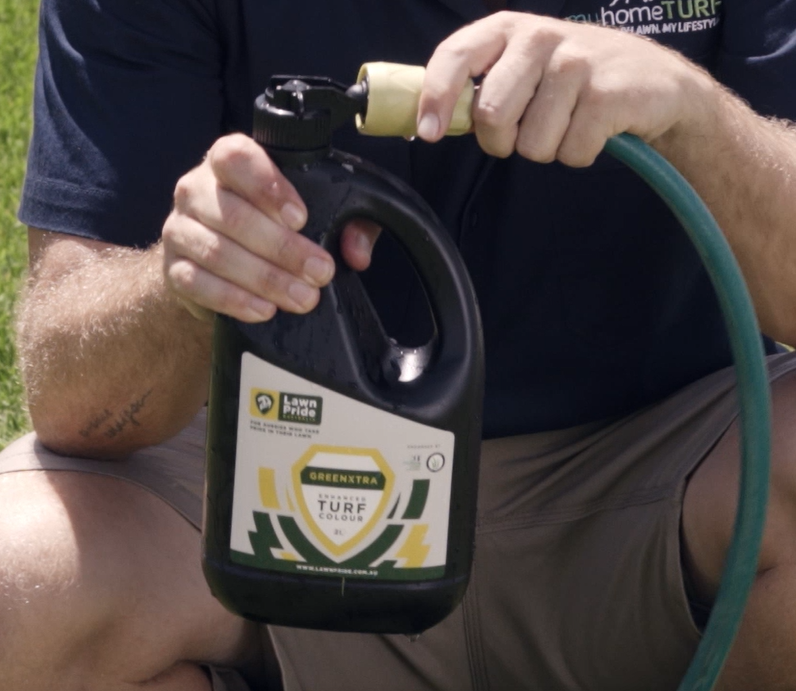 It’s possible to have a beautiful looking lawn in winter thanks to fertilisers – especially a quick green-up liquid fertiliser.
It’s possible to have a beautiful looking lawn in winter thanks to fertilisers – especially a quick green-up liquid fertiliser.
It’s important to aim to have the first winter fertiliser applied BEFORE winter arrives, generally in May.
Your lawn is then prepared for winter by increasing its iron levels and general health.
The second application should be about eight weeks later, which follows general fertilising guidelines. In this case, we are looking at a July application which will feed the lawn with iron and nutrients to help sustain it for the rest of the cold months.
Depending on the coldness of the winter, and the actual temperature of the soil, results can vary when fertilising in winter.
While the nutrients are important to the lawn and will improve the appearance of the lawn in most cases, sudden growths are not expected.
If a lawn is in poor health, and an application of winter fertiliser is applied, it generally will not turn the problem around. Winter lawn fertilising should be included inside of a correct year-round fertilising and lawn care regime.
It is important that you know what sort of grass you have before purchasing your fertiliser, so you buy the correct one. Always read the label before applying and follow the recommendations.
There are a variety of different fertiliser types you can choose from depending on your needs and budget.
Liquid fertilisers have the benefit of being able to be applied to both the ground or to the lawn foliage itself, also called foliar application.
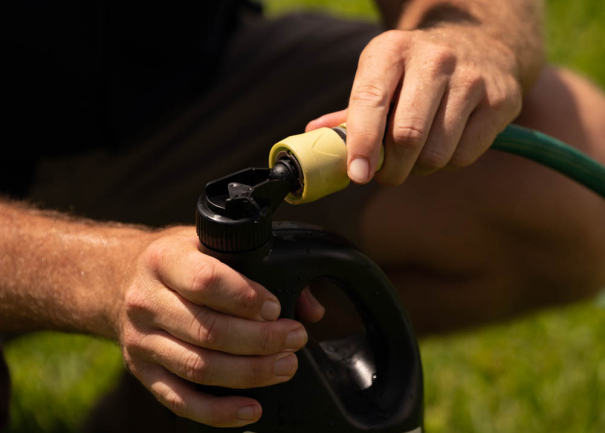 Application of liquid fertiliser during your lawn’s winter dormancy, means it is primarily absorbed through the leaves. Liquid fertiliser therefore gives your lawn a quick reactive green-up just when it is starting to go yellow-brown in colour.
Application of liquid fertiliser during your lawn’s winter dormancy, means it is primarily absorbed through the leaves. Liquid fertiliser therefore gives your lawn a quick reactive green-up just when it is starting to go yellow-brown in colour.
Application to the lawn allows the leaves to absorb the fertiliser and have the nutrients more readily available for immediate use.
Foliar application gives you the option of making mid-season corrections to add vital nutrients to your lawn if it didn’t get the correct mixture at the beginning of the season or if your lawn needs a boost.
Another main benefit of liquid lawn fertiliser is that it can be easily administered to the largest of lawns in a liquid form and absorbed, not only by the lawn foliage itself but also by the surrounding soil.
This is of great value to lawn care and while liquid fertiliser is commonly more expensive it can be more effective!
Again, the best fertiliser for your lawn is one that contains the nutrients your soil needs.
One of the advantages of using a liquid lawn fertilizer is that you can easily mix in any other nutrients your lawn and soil needs.
Whether you mix concentrate in a litre sprayer (the less expensive option) or purchase a pre-mixed bottle that attaches to your garden hose, lawn liquid fertiliser is more versatile than granular because you can apply it to the ground or the leaf foliage.
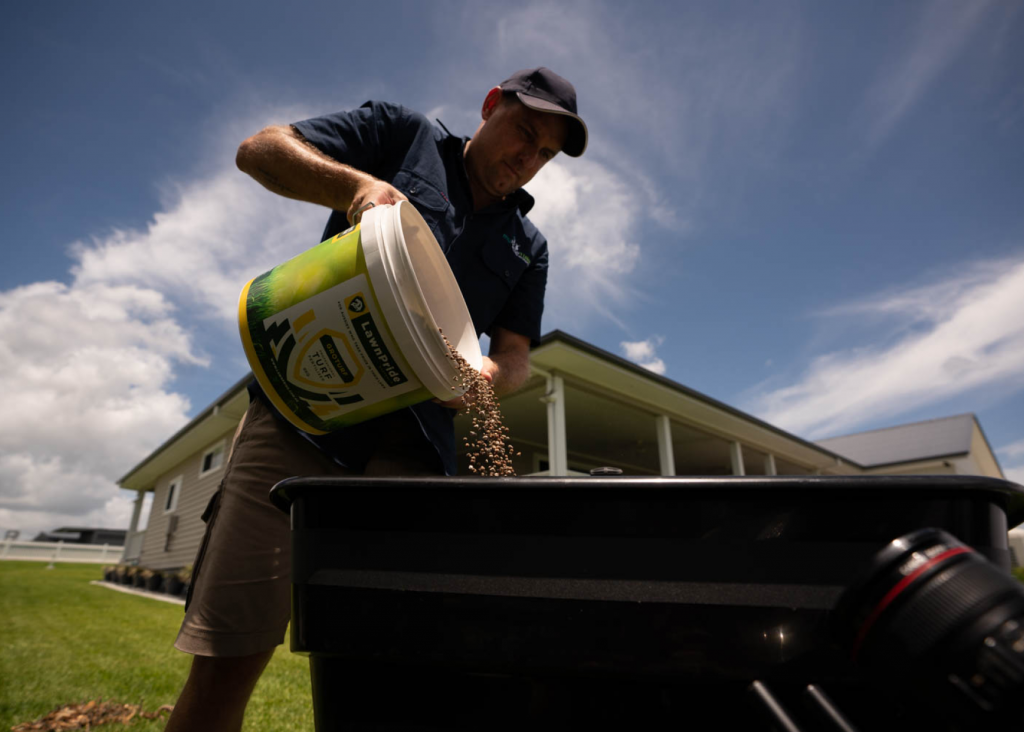 Most lawns respond well to a slow release fertiliser which can be found at the myhomeTURF online shop.
Most lawns respond well to a slow release fertiliser which can be found at the myhomeTURF online shop.
Using a slow release fertiliser on your lawn once during autumn before the ground becomes too cold.
Application of your slow release fertiliser should occur during late March or early April (when the weather is still warm).
Another benefit of a slow release fertiliser is that a consistent level of growth and greening occurs across the life of the application with no spike in growth and no nutrient-run off.
It is important not to use cheap slow release fertilisers as these products tend to initially release a lot of nutrients and dwindle off quickly with nutrient delivery, resulting in an initial surge in growth and greening – however, consistent growth will not be maintained.
Traditional lawn fertiliser is often the cheapest lawn food choice but not necessarily the best.
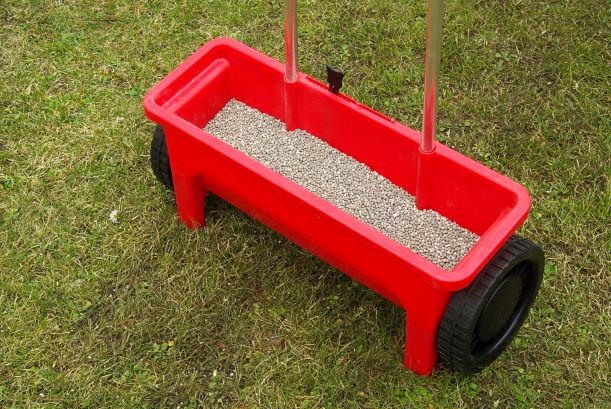 Traditional fertilisers also tend to dump their nutrient load immediately after watering in which often leads to high nutrient run-off into waterways and drains.
Traditional fertilisers also tend to dump their nutrient load immediately after watering in which often leads to high nutrient run-off into waterways and drains.
Application rates for traditional fertilisers are every 4 to 6 weeks and rely on the lawn being able to absorb the nutrients as they move through the soil.
However frequent applications of traditional fertiliser can have detrimental effects on the soil chemistry and therefore health.
A ‘true’ organic fertiliser is one that has been certified as 100% organic – so be sure to have that guaranteed when purchasing.
The simplest way to check that it is 100% organic is by looking for the Australian Organic Certified logo on the bottle or pack.
A recommended organic fertiliser is a blend of both natural (organic) and synthetic (manufactured) fertiliser.
Therefore, the use of organic lawn food and soil improver combines the features of both a slow release fertiliser as well as natural ingredients such as seaweed, fish, manure and bio-stimulants.
Since organic fertiliser are natural products, it is hard to over-fertiliser and in fact, they make your soil and plant health strong.
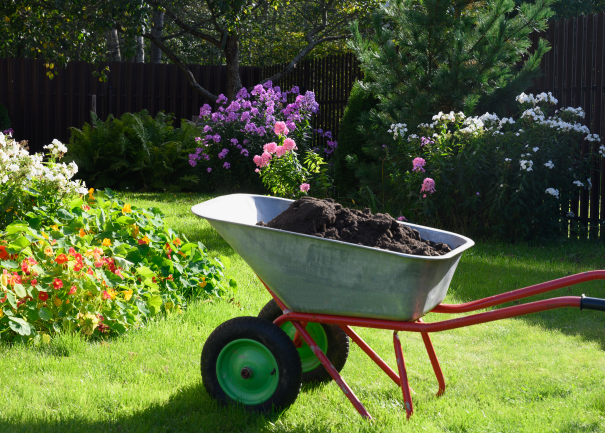 As organic fertilisers can be more expensive than other fertilisers it is possible to make your own by composting manure – such as from cattle or chooks.
As organic fertilisers can be more expensive than other fertilisers it is possible to make your own by composting manure – such as from cattle or chooks.
The best time to apply your organic fertiliser in autumn is either late March or early April.
Another application of organic fertiliser during winter – preferably late June.
New, unique herbicide formulations are available that when combined with fertilizer offer homeowners the ability to fertilize their lawn and control broadleaf weeds in one application.
Many products exist offering a wide variety of NPK and nitrogen sources to match the specific fertility needs of your lawn.
Types of combination products could include, pre-emergent weed control, post-emergent broadleaf weed control, or a combination of both.
One of the most popular combined fertiliser and pre-emergent herbicide products is granular Oxafert which controls Summer Grass, Crowsfoot Grass, Winter Grass and Creeping Oxalis and offers an efficient NPK (nitrogen, phosphorus and potassium) application of fertiliser.
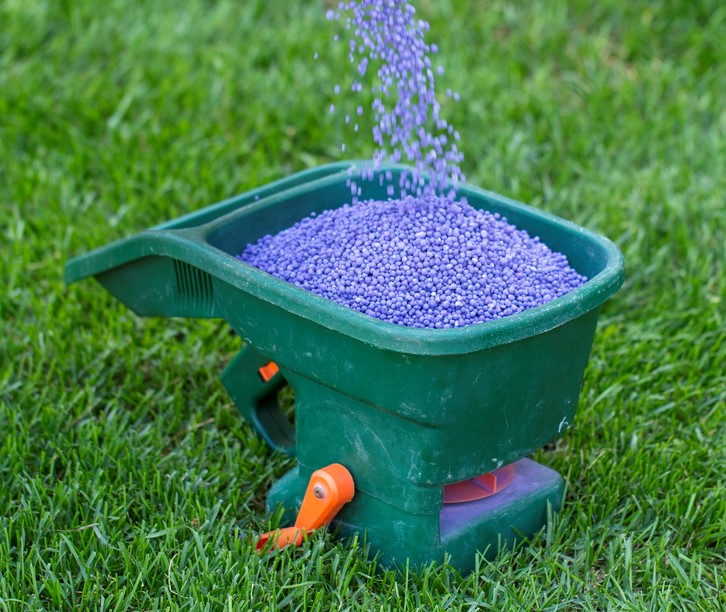 Winter fertilising is now taken care of, once in May before winter, and once in July during winter. It’s as easy as that.
Winter fertilising is now taken care of, once in May before winter, and once in July during winter. It’s as easy as that.
The next fertilising in your lawn care is due in September, at the beginning of spring, using a standard high quality lawn fertiliser.
Being high in Iron, the winter fertilisers we use for our lawn care also have the ability to stain pathways and driveways with drips of rust. This occurs when the fertiliser isn’t applied carefully to the lawn and overspreads onto surrounding areas. When the water arrives, the Iron is released from the fertiliser, resulting in rust stains.
Prevent this by careful application or blowing or hosing paths thoroughly clean after fertilising, and before watering. myhomeTURF recommends fertiliser from our online store.
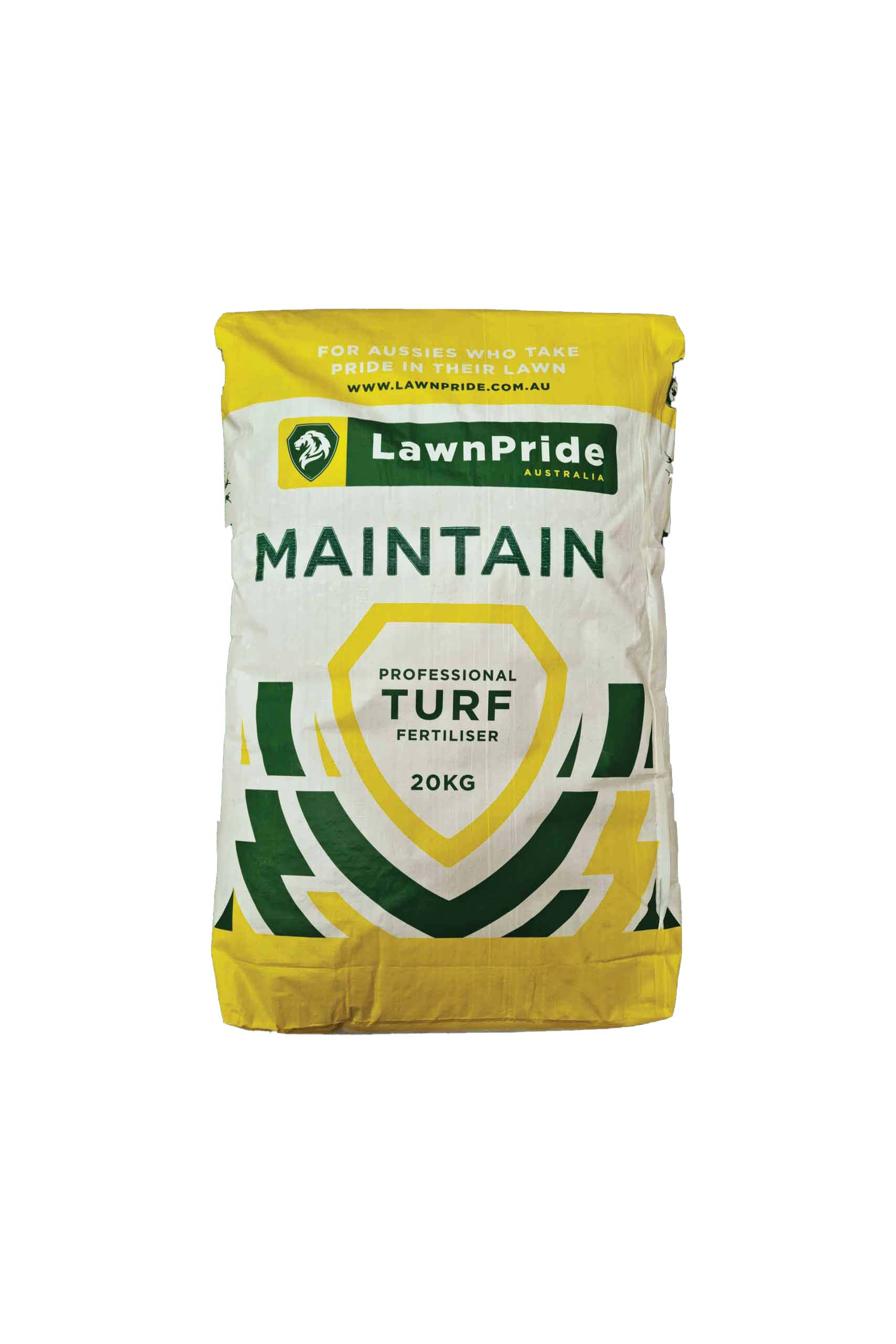
For a slow release fertiliser, Lawn Pride Maintain 26-2-9 + 3.4 Fe 20kg is one of the most popular granular all-round lawn fertilisers on the market with the active ingredients of Nitrogen (N – 26), Phosphorus (P – 2), Potassium(K – 9) and Iron (Fe – 3.4). Suitable for Zoysia, Kikuyu, Couch and Buffalo grasses. Always read the safety directions and instructions on the product label before use.
SHOP NOW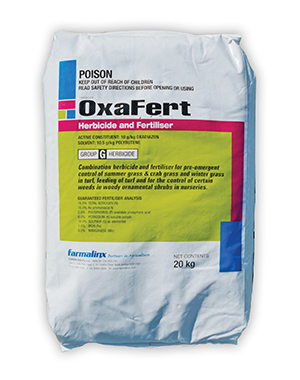
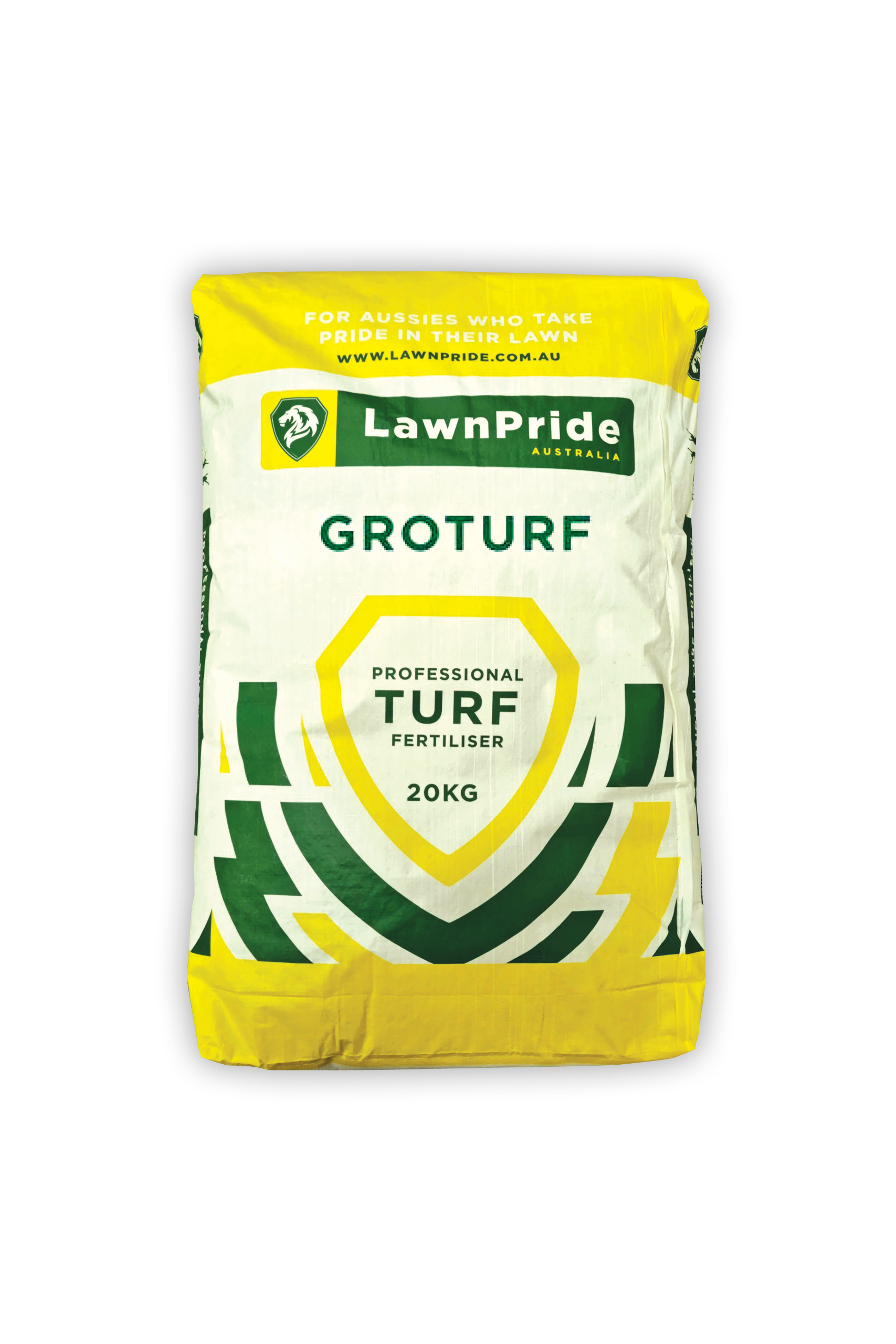
For a traditional lawn fertiliser, LawnPride Groturf 15-4-11 + Traces 20kg is an instant release granular fertiliser designed to initiate rapid growth of your lawn thanks to extra trace elements that build up your soil’s nutrients. Suitable for Zoysia, Kikuyu, Couch and Buffalo grasses. Always read the safety directions and instructions on the product label before use.
SHOP NOW